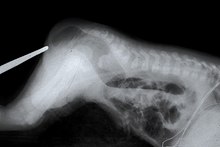| Currarino syndrome | |
|---|---|
| Other names | Currarino triad |
 | |
| An X-ray showing Imperforate anus | |
Currarino syndrome is an inherited congenital disorder where either the sacrum (the fused vertebrae forming the back of the pelvis) is not formed properly, or there is a mass in the presacral space in front of the sacrum, and there are malformations of the anus or rectum. It occurs in approximately 1 in 100,000 people.[1]
Anterior sacral meningocele is the most common presacral mass in patients with Currarino syndrome, occurring in 60% of cases. Its presence may significantly affect the surgical management of these patients.[2][3] Other potential presacral masses include presacral teratoma and enteric cyst. Presacral teratoma usually is considered to be a variant of sacrococcygeal teratoma. However, the presacral teratoma that is characteristic of the Currarino syndrome may be a distinct kind.[4]
- ^ Weber, Stefanie; Dávila, Magdalena (2014). "German approach of coding rare diseases with ICD-10-GM and Orpha numbers in routine settings". Orphanet Journal of Rare Diseases. 9 (Suppl 1): O10. doi:10.1186/1750-1172-9-s1-o10. ISSN 1750-1172. PMC 4249588.
- ^ Emans, Pieter J.; van Aalst, Jasper; van Heurn, Ernest L.W.; Marcelis, Carlo; Kootstra, Gauke; Beets-Tan, Regina G.H.; Vles, Johannes S.H.; Beuls, Emile A.M. (2006-05-01). "The Currarino Triad: Neurosurgical Considerations". Neurosurgery. 58 (5): 924–929. doi:10.1227/01.neu.0000209945.87233.6a. ISSN 0148-396X. PMID 16639328. S2CID 45316326.
- ^ Samuel, M.; Hosie, G.; Holmes, K. (December 2000). "Currarino triad—Diagnostic dilemma and a combined surgical approach". Journal of Pediatric Surgery. 35 (12): 1790–1794. CiteSeerX 10.1.1.603.4599. doi:10.1053/jpsu.2000.19258. ISSN 0022-3468. PMID 11101738.
- ^ Gopal M, Turnpenny PD, Spicer R (June 2007). "Hereditary sacrococcygeal teratoma--not the same as its sporadic counterpart!". Eur J Pediatr Surg. 17 (3): 214–6. doi:10.1055/s-2007-965121. PMID 17638164. S2CID 260135903.